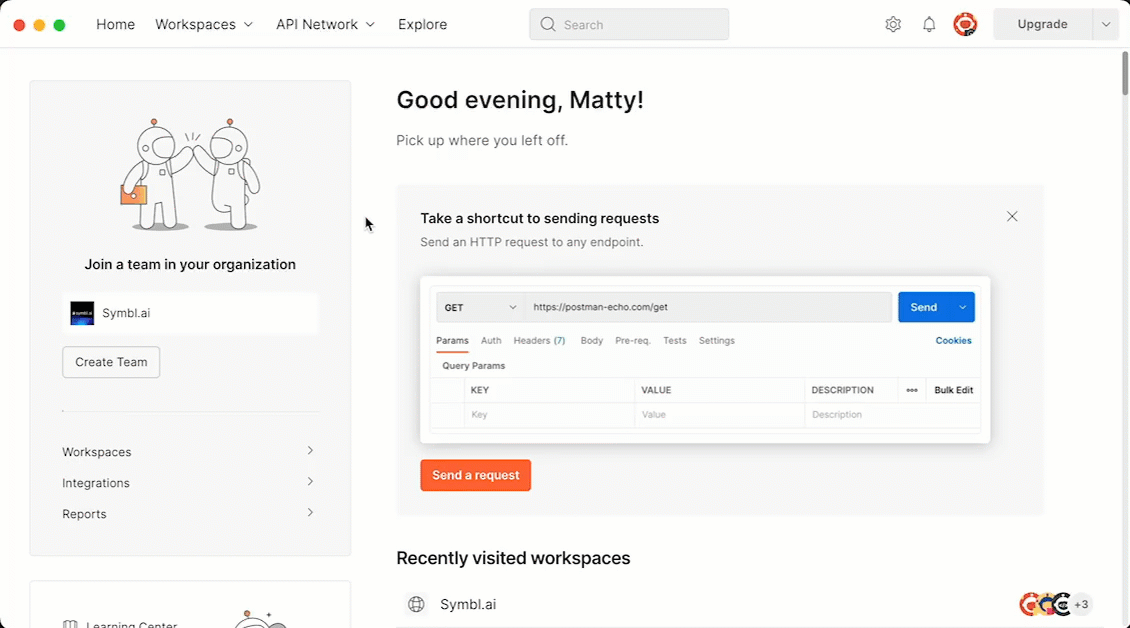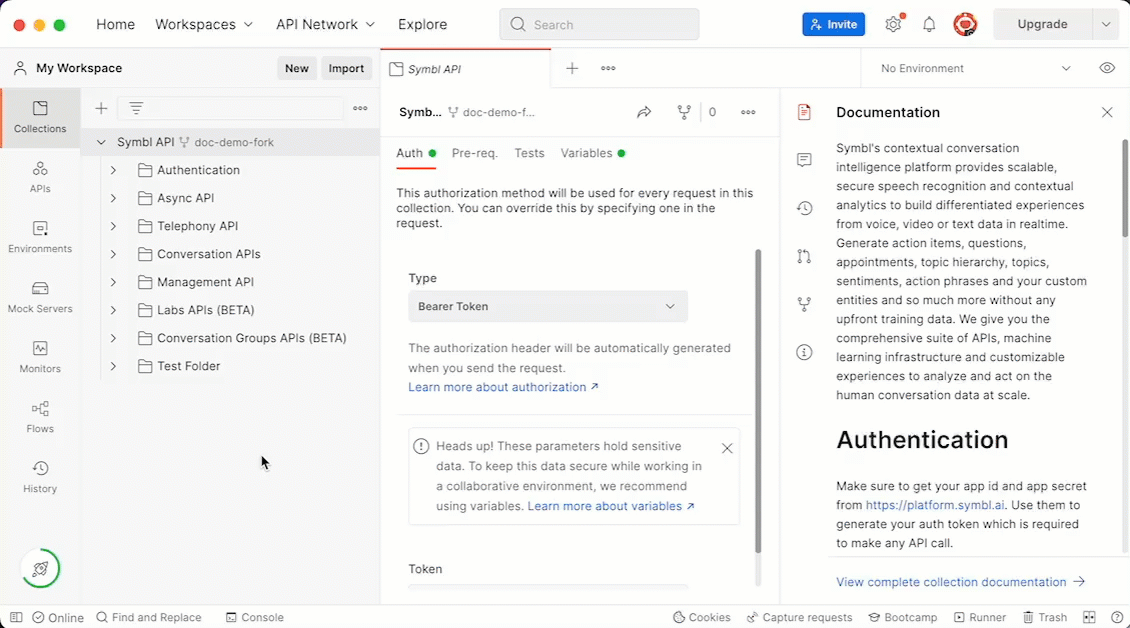Get started with Postman
Postman is a powerful web and desktop application for building and testing APIs. Symbl.ai provides a public workspace featuring our APIs as a tool for exploring the depth of our platform and for quick integration with your app.
This topics describes the Postman interface using terms from the Postman documentation.
Try the Postman public workspace
This section describes how to get Postman and access the Symbl.ai public workspace.
Install Postman
Before you get started with Postman and our public workspace, follow the instructions to install and update Postman.
Get started with the Symbl.ai workspace

To get started with the Symbl.ai workspace in Postman:
-
Open Postman.
-
Sign in to Postman or create a free account. Optionally, you can continue without an account, but some Postman functionality will be limited, such as the ability to watch the Symbl.ai workspace.
-
At the top of the Postman interface, select Search Postman and enter
Symbl.ai.As you enter text, Postman displays a list of results.
-
Select the workspace result labeled Symbl.ai • Symbl.ai.
The Symbl.ai workspace appears in the Postman main work area. From this interface, you can review the API documentation and code in the workspace.
-
Optionally, to be notified in Postman of changes to the Symbl.ai workspace, in the upper-right corner of the workspace, select Watch.
Make requests using Postman
To make requests to the Symbl.ai APIs, you must fork the public workspace and authenticate with your API credentials.
Fork the Symbl.ai public workspace

To fork the public workspace:
-
In the sidebar of the Symbl.ai public workspace, select Symbl API.
-
At the top of the Symbl API tab that appears, select Fork
 .
.You are prompted to label your fork and select a location.
-
Enter a label for your fork, and then select My Workspace, your default personal workspace for Postman.
Your fork of the Symbl.ai workspace appears in Collections in your personal workspace.
Create a Symbl.ai environment

These steps require the API credentials you obtained when you signed up for Symbl.ai.
To store your API credentials for use in Postman, create an environment:
-
At the top of the Postman sidebar, select New > Environment.
A new environment appears in the main work area.
-
At the top of the tab that appears, change the label of the environment to Symbl.ai.
-
In the tab, select Add a new variable and enter
app_id. Next, select Initial Value and paste your app ID. -
Select Add a new variable and enter
app_secret. Next, select Type and change the value to secret. Then, select Initial Value and paste your app secret. -
Save the changes to the environment.
Implement your Symbl.ai environment

Update the Symbl.ai Authentication request to use your variables:
-
In the sidebar, select Collections > Symbl API > Authentication > Generate Token (Authenticate).
-
In the upper-right corner of the main work area, select No Environment and switch to your Symbl.ai environment.
-
In the main work area, select Body. Then, replace lines 3 and 4 with the following:
"appId": "{{app_id}}", "appSecret": "{{app_secret}}" -
To test your environment, select Send.
Postman returns an access token generated by your API credentials. The access token is saved as a variable for your fork of the Symbl.ai workspace and will automatically be used for future requests.
-
Save the changes and send the Generate Token request.
Make your first requests

Follow these steps to get a conversation ID and generate conversation intelligence. These steps can generally be reused for the Conversation APIs requests.
Before you begin, in Postman, select your personal fork of the Symbl API workspace.
To make your first Postman requests to the Symbl.ai APIs:
-
In the Postman sidebar, select Async API > Audio - Submit New Audio File (wav/mp3).
-
In the tab that appears, select Body, and then Select File.
-
Select and submit an .mp3 audio file.
When you submit the audio file, the API returns a conversation ID in the response. Postman automatically assigns the conversation ID to a variable for your fork. Whenever you submit a new file, the conversation ID will be updated.
-
In the Postman sidebar, select Async API > Check Request Status (Job status). Then, in the tab that appears, select Send.
The Async API responds with the processing status of your audio file. To ensure you get complete results when you generate conversational intelligence, the processing job must complete first. When your job is complete, proceed to the next step.
-
In the Postman sidebar, select Conversation APIs > Messages (Transcript). Then, in the tab that appears, select Send.
The Symbl.ai API responds with a list of messages that represent the conversation.
To try more Symbl.ai conversation intelligence features, repeat these steps with the other API requests in your Postman workspace.
Updated over 1 year ago
